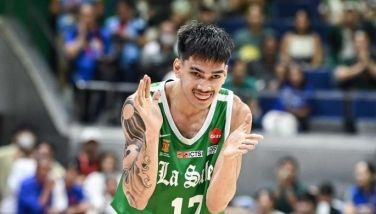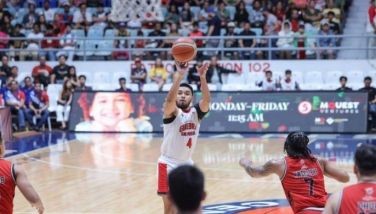How to grow old gracefully

June 12, 2004 | 12:00am
Father Juan Maria H. Ledesma, Jesuit, is 98 years old. He will be 99 on September 5, this year. His hearing is not as good as it used to be; his eyesight is certainly not 20/20; and he moves around Xavier House, in Santa Ana, in a wheel chair. But his mind is alert; his heart is warm; his will is strong; and he greets everyone with a smile. He is growing old, gracefully. Everybody calls him Johnny.
His name is not really Ledesma. It is Howard. His father was an American soldier, named Howard. His mother was named Ledesma. Johnny was born in Iloilo, and does not remember ever seeing his mother. His father went back to the United States, leaving Johnny with the Daughters of Charity of Saint Vincent de Paul, in Hospicio de San Jose.
The Hospicio is in the middle of the Pasig River. You can only get to it from the Ayala Bridge. There is a road leading down from the Bridge to the Hospicio, which is probably the kindest spot in this country. For years the Hospicio had a turning cradle, built into their wall, right alongside their front gate. You could come down that road at midnight with a baby in your arms – deformed, retarded, crippled–and put the baby in the turning cradle, ring the bell, and walk away. No one would put a flashlight in your face. No one would ask your name. You could go back up to the Ayala Bridge and disappear into the city. The Sisters would come out, in the middle of the night, take the baby, and raise the child in their own house.
The Hospicio is the spirit of Saint Vincent de Paul, living in the city, in the middle of the Pasig River.
Johnny was raised by the Sisters for fifteen years. Then he entered San Jose Seminary, which was then on Padre Faura. On October 17, 1924, just after his nineteenth birthday, he entered the Society of Jesus. At that time, this meant just walking up one flight of stairs. San Jose Seminary was on the ground floor, taught by the Jesuits. The novitiate of the Society of Jesus was on the second floor.
In his regency, Johnny taught in San Jose Seminary and in the old Ateneo in Intramuros. You can see the talents of this young man when you look at the subjects assigned to him. Latin, Greek, English, Spanish, Religion, and the History of the Philippines.
It was during these years that Johnny began to be mildly embarrassed by the name "Howard". So he did what was perfectly proper in those days. He changed Juan Maria L Howard to Juan Maria Howard y Ledesma. . . . .Then he drapped the "y". His name became Juan Maria Howard Ledesma. Then he shortened Howard to "H" — Juan Maria H. Ledesma. Then he dropped the "H" and became Johnny Ledesma.
When it came time to choose his citizenship, he was asked: "Do you want to be a citizen of the United Sates of America, or a citizen of the Philippines?" He answered at once: "Philippines! I am a Filipino!"
But, because the Jesuits did not have a theologate in the Philippines at that time, Johnny was sent to Woodstock College, in Woodstock, Maryland, to study theology. There he was ordained on June 21, 1936. He did so well in Woodstock that he was sent to the Gregorian Pontifical University, in Rome, to earn his Doctorate in Sacred Theology.
He came back to the Philippines to teach Dogmatic Theology at San Jose Seminary, which had moved to Balintawak in Caloocan City. During the war, in the Japanese Occupation, he taught both Seminarians of San Jose and the Jesuit Scholastics.
He was my teacher, the kindest of them all. We were hungry at that time. The food was carefully rationed. The fact is, we were hungry for three years and three months. Johnny’s heart went out to us. So, at examination time, he made excellent, clear summaries of all the theses on which we would be examined. He left them on a table, in the central corridor, so that all of us could use them. They were a blessing.
But the Dean was a rigid disciplinarian, and he thought that supplying the students with summaries was not quite cricket. So one day he gathered them all up, and took them away. Johnny went to the Dean and said: "Those are my summaries. You have no right to them. Thou shall not steal!" So the Dean gave them back to Johnny, and gradually they slipped back to us. Johnny really had a heart.
He taught in seminaries for most of his active life. For three years he was borrowed by Indonesia to teach Dogmatic Theology in the Jesuit Theologate in Jogjakarta. Then he was asked by the Bishop of Guam to do research on the life of Diego Luis de San Vitores, a Jesuit who was martyred in Guam. Johnny went at this systematically, intently, with great concentration. It brought him to Guam for two years, and then to Rome, for eight years more. But he did it! San Vitores was first beatified, and then canonized.
While working on this, Johnny suggested that the catechist of San Vitores, who was killed with him, should be included in the request for beatification and canonization. The name of the catechist was Pedro Calungsod, a Visayan. The Bishop of Guam felt that this might delay the processing of the cause of Diego Luis San Vitores, so the catechist was not included.
Years later, when Cardinal Vidal of Cebu wanted to introduce the cause of Pedro Calungsod for canonization, he went to Father Ledesma for guidance. Johnny unearthed all his research on Diego Luis de San Vitores, and this was the evidence presented in the Vatican for Pedro Calungsod. The case was simple and clear. When Calungsod saw the men coming to kill Father San Vitores, he stood between them and the priest, with arms extended. They killed Calungsod to get at the priest. If the priest was a martyr, then Calungsod was a martyr, also. Rome accepted that. Johnny’s research was really world-class.
He wanted to help seminarians. He had started in a seminary, himself, at the age of 15. And he had taught in seminaries for most of his life. So he put together a beautiful little prayer book, which he called: "My Travel Companion". He discovered that the more copies you print, the cheaper the cost of printing. So he printed in quantity.
He put this prayer book on the market, and it sold. Then he began writing letters of appeal, to all his friends, asking help for poor seminarians. Those who received Johnny’s letter were touched, and sent donations. In gratitude, Johnny would send them a copy of "My Travel Companion". He is dedicated to this campaign. In recent years he has been asking for a donation of one thousand pesos.
A good friend of mine, Noel Trinidad, said to me: "You know, I want to write to Johnny, saying: ‘Dear Father Ledesma. I will gladly give you two thousand pesos for your poor seminarians, provided only that you do not send me a copy of My Travel Companion. I already have six copies. You have sent me a copy every year, for the last six years.’ "
My Travel Companion has gone through 20 editions! 915,000 copies! He has published three English editions of the Life of Christ, a synthesis of all four Gospels. 93,000 copies. And ten editions of the Life of Christ in Tagalog, 131,000 copies!
This has enabled him to give substantial subsidies to seminaries in Malaybalay, Bukidnon; in Baguio; in Bontoc; in Cagayan de Oro; in Zamboanga; in Ipil; to his own seminary, San Jose, in Quezon City; to the Jesuit Novitiate in Novaliches; and to the Jesuit Scholasticate at Loyola House of Studies. All this in the last 16 years. The subsidies began when Johnny was 82 years old.
Among the Jesuits in the Philippines, he is unique. At Christmas, at Easter, at birthdays, the Filipino Jesuits always have someone whom they can visit – father, mother, sisters, brothers, nieces, nephews. But Johnny has no family. The American and European Jesuits, working in the Philippines, at least have someone to whom they can write! Johnny has no one. He is a pure Jesuit. The only family he has is us – the Jesuits.
But Johnny smiles, and is alert, working away until this day. He has an apostolate in which he believes, with all his heart – the training of seminarians. He feels that the weak point in the Catholic Church is the priesthood. Those training to be priests must be strengthened. So Johnny is giving them all the strength he has, at the age of 98.
And he knows that he is working for God. He is in the chapel more often, and for longer periods, than any of the rest of us. He has deep peace of soul. He is a model on how to go home to God, gracefully.
His name is not really Ledesma. It is Howard. His father was an American soldier, named Howard. His mother was named Ledesma. Johnny was born in Iloilo, and does not remember ever seeing his mother. His father went back to the United States, leaving Johnny with the Daughters of Charity of Saint Vincent de Paul, in Hospicio de San Jose.
The Hospicio is in the middle of the Pasig River. You can only get to it from the Ayala Bridge. There is a road leading down from the Bridge to the Hospicio, which is probably the kindest spot in this country. For years the Hospicio had a turning cradle, built into their wall, right alongside their front gate. You could come down that road at midnight with a baby in your arms – deformed, retarded, crippled–and put the baby in the turning cradle, ring the bell, and walk away. No one would put a flashlight in your face. No one would ask your name. You could go back up to the Ayala Bridge and disappear into the city. The Sisters would come out, in the middle of the night, take the baby, and raise the child in their own house.
The Hospicio is the spirit of Saint Vincent de Paul, living in the city, in the middle of the Pasig River.
Johnny was raised by the Sisters for fifteen years. Then he entered San Jose Seminary, which was then on Padre Faura. On October 17, 1924, just after his nineteenth birthday, he entered the Society of Jesus. At that time, this meant just walking up one flight of stairs. San Jose Seminary was on the ground floor, taught by the Jesuits. The novitiate of the Society of Jesus was on the second floor.
In his regency, Johnny taught in San Jose Seminary and in the old Ateneo in Intramuros. You can see the talents of this young man when you look at the subjects assigned to him. Latin, Greek, English, Spanish, Religion, and the History of the Philippines.
It was during these years that Johnny began to be mildly embarrassed by the name "Howard". So he did what was perfectly proper in those days. He changed Juan Maria L Howard to Juan Maria Howard y Ledesma. . . . .Then he drapped the "y". His name became Juan Maria Howard Ledesma. Then he shortened Howard to "H" — Juan Maria H. Ledesma. Then he dropped the "H" and became Johnny Ledesma.
When it came time to choose his citizenship, he was asked: "Do you want to be a citizen of the United Sates of America, or a citizen of the Philippines?" He answered at once: "Philippines! I am a Filipino!"
But, because the Jesuits did not have a theologate in the Philippines at that time, Johnny was sent to Woodstock College, in Woodstock, Maryland, to study theology. There he was ordained on June 21, 1936. He did so well in Woodstock that he was sent to the Gregorian Pontifical University, in Rome, to earn his Doctorate in Sacred Theology.
He came back to the Philippines to teach Dogmatic Theology at San Jose Seminary, which had moved to Balintawak in Caloocan City. During the war, in the Japanese Occupation, he taught both Seminarians of San Jose and the Jesuit Scholastics.
He was my teacher, the kindest of them all. We were hungry at that time. The food was carefully rationed. The fact is, we were hungry for three years and three months. Johnny’s heart went out to us. So, at examination time, he made excellent, clear summaries of all the theses on which we would be examined. He left them on a table, in the central corridor, so that all of us could use them. They were a blessing.
But the Dean was a rigid disciplinarian, and he thought that supplying the students with summaries was not quite cricket. So one day he gathered them all up, and took them away. Johnny went to the Dean and said: "Those are my summaries. You have no right to them. Thou shall not steal!" So the Dean gave them back to Johnny, and gradually they slipped back to us. Johnny really had a heart.
He taught in seminaries for most of his active life. For three years he was borrowed by Indonesia to teach Dogmatic Theology in the Jesuit Theologate in Jogjakarta. Then he was asked by the Bishop of Guam to do research on the life of Diego Luis de San Vitores, a Jesuit who was martyred in Guam. Johnny went at this systematically, intently, with great concentration. It brought him to Guam for two years, and then to Rome, for eight years more. But he did it! San Vitores was first beatified, and then canonized.
While working on this, Johnny suggested that the catechist of San Vitores, who was killed with him, should be included in the request for beatification and canonization. The name of the catechist was Pedro Calungsod, a Visayan. The Bishop of Guam felt that this might delay the processing of the cause of Diego Luis San Vitores, so the catechist was not included.
Years later, when Cardinal Vidal of Cebu wanted to introduce the cause of Pedro Calungsod for canonization, he went to Father Ledesma for guidance. Johnny unearthed all his research on Diego Luis de San Vitores, and this was the evidence presented in the Vatican for Pedro Calungsod. The case was simple and clear. When Calungsod saw the men coming to kill Father San Vitores, he stood between them and the priest, with arms extended. They killed Calungsod to get at the priest. If the priest was a martyr, then Calungsod was a martyr, also. Rome accepted that. Johnny’s research was really world-class.
He wanted to help seminarians. He had started in a seminary, himself, at the age of 15. And he had taught in seminaries for most of his life. So he put together a beautiful little prayer book, which he called: "My Travel Companion". He discovered that the more copies you print, the cheaper the cost of printing. So he printed in quantity.
He put this prayer book on the market, and it sold. Then he began writing letters of appeal, to all his friends, asking help for poor seminarians. Those who received Johnny’s letter were touched, and sent donations. In gratitude, Johnny would send them a copy of "My Travel Companion". He is dedicated to this campaign. In recent years he has been asking for a donation of one thousand pesos.
A good friend of mine, Noel Trinidad, said to me: "You know, I want to write to Johnny, saying: ‘Dear Father Ledesma. I will gladly give you two thousand pesos for your poor seminarians, provided only that you do not send me a copy of My Travel Companion. I already have six copies. You have sent me a copy every year, for the last six years.’ "
My Travel Companion has gone through 20 editions! 915,000 copies! He has published three English editions of the Life of Christ, a synthesis of all four Gospels. 93,000 copies. And ten editions of the Life of Christ in Tagalog, 131,000 copies!
This has enabled him to give substantial subsidies to seminaries in Malaybalay, Bukidnon; in Baguio; in Bontoc; in Cagayan de Oro; in Zamboanga; in Ipil; to his own seminary, San Jose, in Quezon City; to the Jesuit Novitiate in Novaliches; and to the Jesuit Scholasticate at Loyola House of Studies. All this in the last 16 years. The subsidies began when Johnny was 82 years old.
Among the Jesuits in the Philippines, he is unique. At Christmas, at Easter, at birthdays, the Filipino Jesuits always have someone whom they can visit – father, mother, sisters, brothers, nieces, nephews. But Johnny has no family. The American and European Jesuits, working in the Philippines, at least have someone to whom they can write! Johnny has no one. He is a pure Jesuit. The only family he has is us – the Jesuits.
But Johnny smiles, and is alert, working away until this day. He has an apostolate in which he believes, with all his heart – the training of seminarians. He feels that the weak point in the Catholic Church is the priesthood. Those training to be priests must be strengthened. So Johnny is giving them all the strength he has, at the age of 98.
And he knows that he is working for God. He is in the chapel more often, and for longer periods, than any of the rest of us. He has deep peace of soul. He is a model on how to go home to God, gracefully.
BrandSpace Articles
<
>
- Latest
- Trending
Trending
Latest
Recommended




























